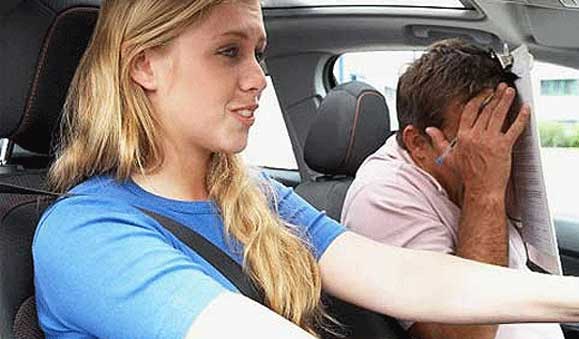Most common mistakes made by new drivers during the road test

Passing the road test is the last step to get your driving license in BC (and probably in other provinces/states too). So getting ready for your road test is very important. This final test will determine if you are going to get your license or not. Our trainers give extra tips and guidance to all new drivers who are going to take the road test and make sure that they understand the basics. As we have dealt with many drivers, there are some repeated mistakes that most of the people make. We are going to list the most vivid ones and help you get rid of them so that you successfully pass your examination.
And as we know that you are new to driving and so does your examiner, so you are not supposed to be an expert on your day of test. Some people are a little frightened and scared in front of the examiner which is normal. You may make some mistakes which will lower your score but will not make you fail the test. But there are some which will get you fail, no matter what your test score was otherwise.
Not making a complete stop: Most of people do not make a complete stop on stop signs. They slow down a bit and see if the road is clear and accelerate again. This is wrong and will probably hurt your scores a lot. These stop signs mean a complete stop. So, make sure you stop completely before the line and then proceed. Keep in mind that you don’t have to stop there for some specific time.
Turning right without stopping: It is true that you can turn right on a red light, but it’s also true that you have to stop first and then turn right. We know people just slow down a bit and then turn. Teenagers learn this habit from their elders. So keep in mind that whatever your elders do is not always right. And parents also should be careful and should inforce good driving skills to their teens.
Not driving in the speed limits: Most of the drivers think its fine to drive at 38 Km/hour in 30 Km/hour area. May be its OK until 32, 33 but it is not fine to go up by 8 Km/hr. It will probably get you fail mark if you do that on the day of your test. Now, we know it’s hard for a new driver to keep track of the speed while taking care of all other stuff. It could be overwhelming at first, but that’s where all driving schools comes to play. You have the training so you get some experience in driving. And you don’t have to keep looking at your speedometer all the time, just make sure you’re below the speed limit so if in case you bump the speed up a bit, you’d still be safe. While it is not illegal to drive at 25 Km/hr in 30 Km/hr area but you should not go very slowly, like 15 or 20.
Not doing shoulder checks: When driving in clear area, people sometimes forget to do the shoulder check as they anticipate that the examiner would understand that the road was clear. Keep in mind that your examiner is not testing your superpowers or your abilities to predict the road traffic. Even if you know that there is no one coming your way, you should still make sure by shoulder checking. Show the ICBC experts that you read the guide well and follow the rules. Shoulder checking is mostly required when changing lanes, turning right and getting in/out to traffic.
Forgetting to turn off the parking brake: This habit is so common that even many experienced drivers sometimes drive with parking brake on when getting out of a parking lot. And mind it that the solution is not to stop using the parking brake but to start making a habit of checking the hand brake every time you are going to start the vehicle.
Issues with pedestrians: There are many cases when pedestrians start crossing the street when they should not be. Your job as a driver is not to start fighting but to help and to make safe and smart decisions. Do not try to cut pedestrians off or go so close to them that you scare the hell out of them. Make a stop before the line and give them time to cross the street. Sometimes its older people who take more time than normal but that does not mean that you should start driving and hit them.
Using just one hand to drive: This is a very common habit of people who have been driving manual in their home countries. Most of the Indian drivers struggle with this habit. They don’t think it’s necessary to put both of your hands on the wheel while you can do the job with just one hand. Well, first of all it’s a regulation set by ICBC that you do shuffle steering (hand over hand is also fine) and secondly, try testing it on your vehicle and you can save a lot on your auto repairs.
Along with these there are few other things such as driving too slowly, non-safe vehicle and not being able to park if required. Note that if the ICBC officer asks you to park, he is not hoping you to be perfect. You should be able to park the vehicle without hitting any other vehicles but there are no time limits or anything. If you are prepared enough, you will have the basic skills to complete the task. Just be confident and calm. And as the Insurance Corporation of British Columbia’s book title says, “Drive smart”. Happy driving and best of luck from our team. Hope you will pass the test with good scores.
